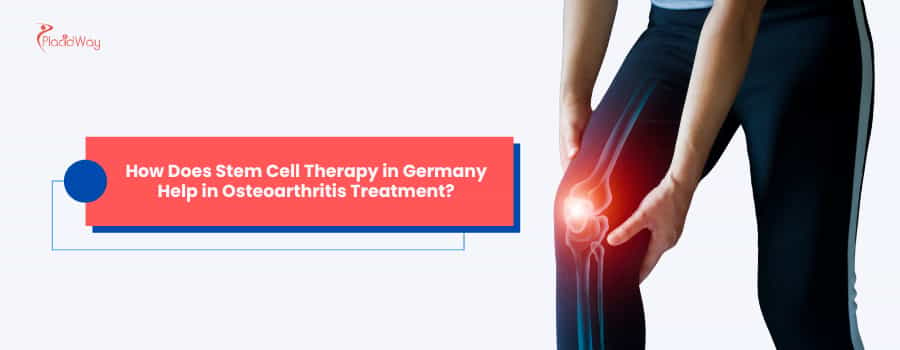Stem Cell Therapy for Osteoarthritis in Germany
"Stem cell therapy in Germany helps in osteoarthritis treatment by utilizing the regenerative and anti-inflammatory properties of stem cells, often mesenchymal stem cells (MSCs), to potentially repair damaged cartilage, reduce pain, and improve joint function."

Osteoarthritis, a widespread chronic condition, primarily affects the cartilage in joints, leading to pain, stiffness, and reduced mobility. For many years, conventional treatments have focused on managing symptoms rather than addressing the underlying cause. However, advancements in regenerative medicine, particularly stem cell therapy, are offering new hope. Germany has emerged as a leading country in the field of stem cell therapy for osteoarthritis, providing cutting-edge treatments that aim to harness the body's natural healing mechanisms to repair damaged tissues and reduce inflammation. This innovative approach seeks to improve the quality of life for individuals suffering from this debilitating joint disease.
"Osteoarthritis is a degenerative joint disease characterized by the breakdown of joint cartilage and underlying bone, leading to pain, stiffness, and swelling, primarily affecting the weight-bearing joints."
Osteoarthritis, often referred to as "wear and tear" arthritis, is the most common form of arthritis. It occurs when the protective cartilage on the ends of your bones wears down over time. Cartilage is a firm, slippery tissue that enables nearly frictionless joint motion. In osteoarthritis, this cartilage becomes rough and eventually erodes, causing bones to rub directly against each other. This friction leads to pain, inflammation, swelling, and reduced flexibility in the affected joint. The progression of osteoarthritis can significantly impair a person's ability to perform daily activities, impacting their overall quality of life. Common joints affected include the knees, hips, hands, and spine.
"Stem cells are unique cells with the ability to self-renew and differentiate into various specialized cell types, playing a crucial role in the body's natural repair and regeneration processes."
Stem cells are often called the body's raw materials. They are undifferentiated cells that have two key characteristics: first, they can divide and produce more stem cells (self-renewal); and second, they can develop into many different cell types in the body (differentiation). In the context of regenerative medicine, these properties are invaluable. For osteoarthritis treatment, mesenchymal stem cells (MSCs) are particularly relevant due to their potential to differentiate into cartilage-producing cells (chondrocytes), bone cells (osteoblasts), and fat cells (adipocytes). Beyond differentiation, stem cells also have immunomodulatory and anti-inflammatory properties, meaning they can help reduce inflammation and promote a healing environment within the joint.
" primarily targets osteoarthritis by injecting autologous stem cells (usually Mesenchymal Stem Cells from bone marrow or fat) directly into the affected joint to promote cartilage regeneration, reduce inflammation, and alleviate pain."
In Germany, stem cell therapy for osteoarthritis typically involves harvesting stem cells from the patient's own body, most commonly from bone marrow (Bone Marrow Aspirate Concentrate, BMAC) or adipose tissue (fat). These autologous stem cells are then processed to concentrate the mesenchymal stem cells (MSCs). Once processed, the concentrated stem cells are precisely injected into the osteoarthritic joint. The goal is for these MSCs to either differentiate into new cartilage cells or, more commonly, to exert their therapeutic effects through paracrine signaling. This means they release growth factors and anti-inflammatory molecules that encourage the body's own repair mechanisms, reduce pain, and slow down cartilage degradation. German clinics often employ advanced imaging techniques to ensure the precise placement of the into the damaged area.
"For , the primary type of stem cells used are Mesenchymal Stem Cells (MSCs), typically harvested from the patient's own bone marrow or adipose (fat) tissue."
Mesenchymal Stem Cells (MSCs) are multipotent stromal cells that can differentiate into various cell types, including chondrocytes (cartilage cells), osteoblasts (bone cells), and adipocytes (fat cells). Their multipotent nature and immunomodulatory properties make them ideal candidates for osteoarthritis treatment.
In Germany, the focus is generally on using autologous stem cells to minimize the risk of immune rejection or disease transmission, aligning with stringent safety regulations.
"Potential benefits of stem cell therapy for osteoarthritis include pain reduction, improved joint function and mobility, potential for cartilage regeneration, and a reduced need for more invasive surgeries like joint replacement."
Stem cell therapy aims to go beyond just managing symptoms. The proposed benefits are:
These benefits can vary from person to person, and the long-term effects are still under ongoing research.
"The typically involves a consultation and diagnostic imaging, stem cell harvesting (from bone marrow or fat), processing to concentrate the MSCs, and then precise injection of the stem cells into the affected joint, often guided by imaging."
The procedure generally follows several steps:
"The recovery process after stem cell therapy for osteoarthritis is typically minimal, with most patients experiencing mild soreness for a few days, and a gradual improvement in symptoms over several weeks to months as the stem cells work."
Unlike surgical interventions, stem cell therapy is a minimally invasive procedure, leading to a relatively quick initial recovery. Patients can usually return to light activities within a few days. Some common post-injection experiences include:
Individual recovery times can vary based on the patient's overall health, the severity of their osteoarthritis, and adherence to post-treatment guidelines.
"While generally considered safe, stem cell therapy for osteoarthritis carries minimal risks, including temporary pain or swelling at the injection site, infection, or, rarely, an allergic reaction; serious adverse events are uncommon, especially with autologous stem cells."
As with any medical procedure, there are potential risks, though those associated with autologous stem cell therapy are typically low:
It's crucial for patients to discuss all potential risks and benefits with their healthcare provider.
"The typically ranges from , varying based on the clinic, the type and source of stem cells used, the severity of the osteoarthritis, and the number of joints treated."
The price of stem cell therapy can be a significant consideration. In Germany, several factors influence the final cost:
Patients should request a detailed cost breakdown from the clinic before proceeding with treatment.
"The is promising, with many patients reporting significant improvements in pain and function; however, it varies depending on individual factors, the severity of the condition, and the specific treatment protocol."
While not a guaranteed cure, numerous studies and clinical experiences in Germany suggest positive outcomes for stem cell therapy in osteoarthritis. Success is often measured by:
It's important to understand that individual results can vary. Factors like age, overall health, the stage of osteoarthritis, and adherence to post-treatment recommendations can all influence the outcome. German clinics often emphasize a personalized approach to maximize potential benefits for each patient.
"German regulation ensures the safety and efficacy of stem cell therapy through stringent oversight by bodies like the Federal Institute for Drugs and Medical Devices (BfArM) and the Paul-Ehrlich-Institut, which authorize and monitor stem cell therapies, ensuring high scientific and ethical standards."
Germany has a robust and well-defined regulatory framework for stem cell therapy, which is a significant reason for its reputation in the field. Key aspects include:
These regulations help instill confidence in patients seeking .
"When choosing a , consider the clinic's accreditation and certifications, the experience and specialization of the medical team, the type of stem cells used, the transparency of costs, and patient testimonials or success stories."
Selecting the right clinic is crucial for a successful stem cell therapy experience. Here are key factors to consider:
"Stem cell therapy may help prevent or delay joint replacement surgery by potentially regenerating damaged cartilage, reducing inflammation, and improving joint function, especially in the earlier stages of osteoarthritis."
For many individuals suffering from osteoarthritis, joint replacement surgery is often considered a last resort. Stem cell therapy offers a less invasive alternative that aims to address the root cause of the problem. By promoting cartilage repair and reducing inflammation within the joint, stem cell therapy can potentially:
While stem cell therapy is not a guaranteed preventative measure for everyone, especially those with very advanced osteoarthritis, it presents a viable option for many patients seeking to avoid or delay joint replacement surgery.
"Germany is at the forefront of stem cell research and clinical trials for osteoarthritis, focusing on optimizing stem cell dosages, delivery methods, and long-term efficacy, with studies involving mesenchymal stem cells from various sources."
German medical institutions and research centers are actively involved in advancing the field of stem cell therapy for osteoarthritis. This includes:
This continuous research ensures that stem cell therapy in Germany remains at the cutting edge of medical innovation.
"Stem cell therapy is not considered a definitive cure for osteoarthritis, but rather a regenerative treatment that aims to significantly alleviate symptoms, improve joint function, and potentially slow down the progression of cartilage degeneration."
It's important to have realistic expectations about stem cell therapy. While it offers significant promise and can lead to substantial improvements for many patients, it is not currently understood as a "cure" that completely reverses all damage or guarantees a permanent solution to osteoarthritis. Instead, it functions as a powerful regenerative treatment that:
Therefore, patients should view stem cell therapy as a highly effective management and regenerative strategy rather than an outright cure.
"The eligibility criteria for stem cell therapy in Germany typically involve a diagnosis of osteoarthritis, good general health, realistic expectations, and an evaluation by a specialist to determine if the patient is a suitable candidate for the specific stem cell protocol."
Eligibility for stem cell therapy is determined on a case-by-case basis after a thorough medical evaluation. While criteria can vary slightly between clinics and specific protocols, general considerations include:
A specialized medical team in Germany will conduct a comprehensive assessment to determine if stem cell therapy is the most appropriate and beneficial option for each individual patient.
"Current research on stem cell therapy for osteoarthritis suggests that long-term side effects are rare, especially with autologous mesenchymal stem cells, with most reported adverse events being mild and temporary, such as localized pain or swelling."
The long-term safety profile of stem cell therapy, particularly using autologous mesenchymal stem cells (MSCs), is a significant focus of ongoing research and clinical monitoring in Germany and worldwide. To date, substantial evidence points to a generally favorable safety record:
While research is ongoing and the field is constantly evolving, the current understanding suggests that autologous stem cell therapy for osteoarthritis carries a low risk of significant long-term side effects.
"The typical timeline for results after stem cell therapy for osteoarthritis usually involves initial improvements in pain and comfort within a few weeks, with more significant and sustained benefits in pain reduction and functional improvement becoming noticeable over 3 to 6 months, and potentially continuing for up to a year."
The effects of stem cell therapy are not instantaneous because the treatment relies on the body's natural healing and regenerative processes. Here's a general timeline:
It's important to remember that these are general timelines, and individual responses can differ based on the severity of the osteoarthritis, the patient's overall health, and adherence to any post-treatment recommendations.
"Physical therapy after stem cell treatment for osteoarthritis is crucial for optimizing outcomes by improving joint strength, flexibility, and stability, aiding in functional recovery, and helping integrate the regenerative effects of the stem cells."
Physical therapy plays a vital role in maximizing the benefits of stem cell therapy and supporting long-term joint health. It is often an integral part of the overall treatment plan in Germany.
A tailored physical therapy program, often starting with gentle exercises and gradually progressing, is typically recommended to complement the stem cell treatment.
"Stem cell therapy uses undifferentiated cells (like MSCs) with the potential to differentiate and promote tissue regeneration, while Platelet-Rich Plasma (PRP) uses concentrated platelets from the patient's blood to deliver growth factors that stimulate healing and reduce inflammation, both applied for osteoarthritis."
Both stem cell therapy and PRP (Platelet-Rich Plasma) are regenerative treatments for osteoarthritis, but they differ in their fundamental components and mechanisms:
- Components: Involves drawing a small amount of the patient's blood, which is then centrifuged to separate and concentrate the platelets. Platelets are rich in various growth factors.
- Mechanism: PRP contains a high concentration of growth factors that signal to the body's existing cells to accelerate healing, reduce inflammation, and promote cell proliferation. PRP primarily enhances the body's natural healing response rather than introducing new undifferentiated cells for regeneration.
While both aim to reduce pain and improve function in osteoarthritis, stem cell therapy is generally considered a more advanced and potentially more powerful regenerative treatment due to the unique properties of stem cells themselves, beyond just growth factors. Often, these treatments can be used in combination for enhanced effects.
Explore PlacidWay for solutions related to medical tourism, healthcare services, or other relevant offerings.









:max_bytes(150000):strip_icc()/sl-weck-jars-amazon-deal-912bb1965fbe410dbb7a69991e6bb802.jpg)
